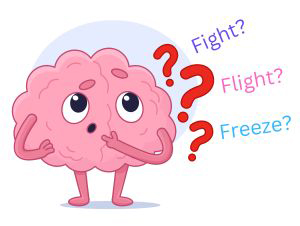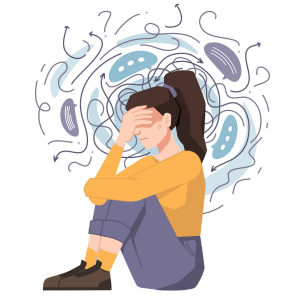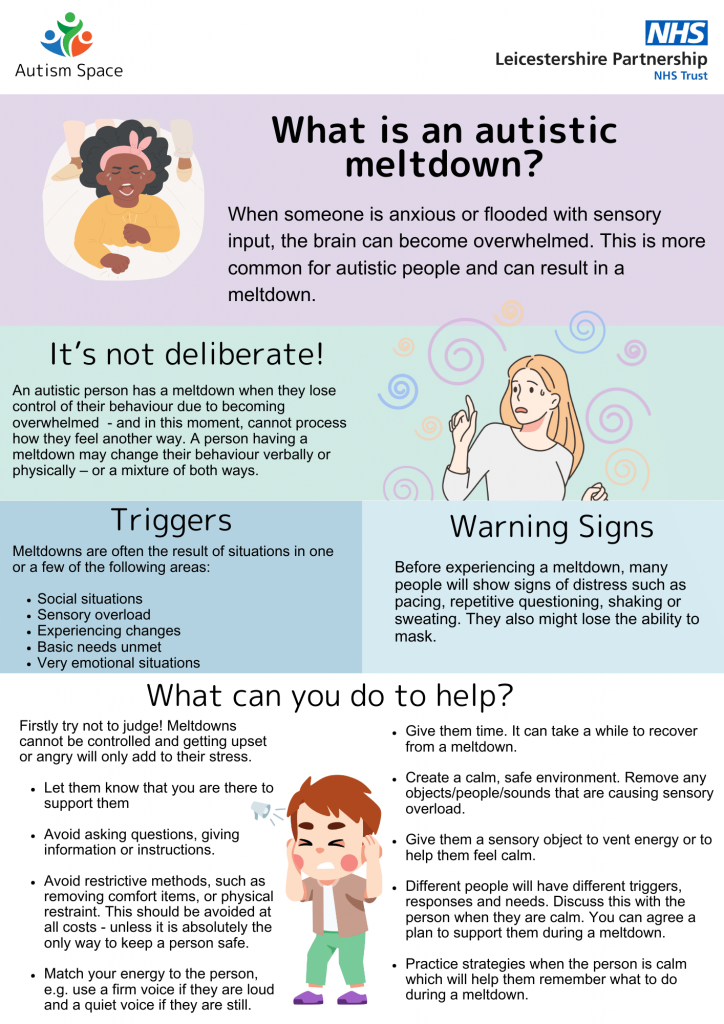Meltdowns – What are they?

“A meltdown is a loss of control – usually as a result of sensory or emotional overwhelm. These are not tantrums as they are not purposefully motivated towards seeking support”
– Quote from CAPTAP. Click here to view the full document from CAPTAP
When someone is in a state of high anxiety or flooded with sensory input the brain can become overwhelmed and demand a fight, flight, or freeze response from the body. In autistic people this can result in a meltdown (the equivalent of the ‘fight’ response) which is often mistaken for a temper tantrum.
Meltdowns can be expressed verbally (eg, shouting, growling, or crying), physically (eg, kicking or flapping) or a mixture of both ways. An autistic person will lose control of their behaviour because they are completely overwhelmed and are unable to express themselves another way.
The video below by Ambitious about Autism is a useful clip of a young person explaining meltdowns.
This video was not produced by Leicestershire Partnership NHS Trust and may contain adverts.
Meltdowns are often the result of situations with high demand in one or a few of the following areas:
- Social situations (for example social anxiety or misunderstandings)
- Sensory overload (for example to much noise, light, itchy clothes)
- Experiencing changes and unpredictable things
- Basic Needs (for example overtired, hungry, thirsty, in pain)
- Very emotional situations
It can look like it is something really tiny that’s triggered a meltdown but in reality it is usually a build-up of multiple factors.
Before experiencing a meltdown, many people will show signs of distress beforehand such as pacing, repetitive questioning or signs of anxiety. They also might lose the ability to mask. It is possible to prevent this from escalating by removing the potential triggers, distraction, or diversion.
Below is a helpful infographic about meltdowns:
Click here to download the meltdowns infographic as a PDF
Below is a helpful video from some of our NHS clinicians and a lived experience partner, explaining autistic meltdowns:
Click here to see a transcript of this video
Shutdowns – what are they?

“A shutdown is again usually caused by sensory, emotional or informational overwhelm – this time leading to feeling or becoming unresponsive, dissociative, numb – Sometimes resulting in situational mutism (where one is unable to communicate or speak)”
– Quote from CAPTAP. Click here to view the full document from CAPTAP
A shutdown has similar feelings as a meltdown however instead of being shown outwardly they are all trapped inside. A shutdown is the equivalent of the ‘freeze’ response when the brain chooses between fight, flight, or freeze. They can be caused by the same things as with meltdowns and are usually a response to sensory overload.
A person having a shutdown might:
- Find it difficult to speak or might not talk at all.
- Want to hide away somewhere dark and alone or curl up in bed.
- Feel like they suddenly have no energy at all and want to sleep or find it difficult to move.
- Have less patience and difficulty regulating emotions.
- Increased stimming.
- Making decisions becomes impossible.
- Difficulty regulating temperature.
- Masking more than usual.
The video below by Ambitious about Autism is a useful clip of a young person explaining shutdowns.
This video was not produced by Leicestershire Partnership NHS Trust and may contain adverts.
An autistic person may become fully non-verbal and completely close or remove themselves from the world and stay curled up in bed. It’s important to give them the space they need to reset and remember that this will only be temporary.
In the video below our clinicians and lived experience partner explain shutdowns:
Click here to view a transcript of this video
What can you do to help in a meltdown or shutdown?
Firstly, try not to judge! Meltdowns and shutdown are not something that an autistic person can control and getting upset or angry with them will only make the situation worse.
The best thing you can do is letting them know that you’re there with them to support them. Avoid asking questions, giving information or instructions, or using restrictive methods. Any of these would likely make the situation worse. Different people will have different triggers and responses, the best thing is to discuss their needs when they’re calm. That way you can agree a plan for the best way to deal with a meltdown or shutdown.
While in a meltdown a person can injure themselves or others however the newest guidance is to use the least restrictive methods possible to help the person feel calmer and more comfortable.
Some things you can try when a meltdown or shutdown is happening (but it’s always best to discuss this with your autistic person first if you can):
- When responding to a meltdown try and match your energy to the person so if they are shouting and lashing out then it could be best to approach with a firm voice and some level of energy in your body language; if they are very quiet and not moving much, it will be best for you to use a calm, quiet voice and be quite still.
- Give them time. It can take a while to recover from sensory overload or situation overwhelm.
- Try to create a quiet, safe space as best you can. Remove any objects/people/sounds that are creating sensory overload if possible.
- For helping a person to calm down from a meltdown try giving them a rolled-up towel (or coat or something strong and made of fabric) and get them to give it a very big twist – then let go, twist again, repeat. You can model this and join in. You can also encourage them to practise this when they are calmer so that it easier to remember when they are not so calm.
- Breathing techniques can also help. For example: breathe in for a count of 3, hold for 3, breath out for 6…. This can help to reset the mind and body.
How to help prevent a meltdown or shutdown happening in the first place
You can try and avoid a meltdown or shutdown from happening in the first place by identifying and eliminating some of the triggers listed earlier in this article. Which of these are applicable will depend very much on the individual.
Autistic people get a lot of benefit from spending time doing the things they love (often called ‘special interests’) Click here to see an article on special interests.
It can help regulate emotions, feel calmer and give more thinking space and energy for dealing with other challenges – it’s just like recharging a battery! If you can, help to find plenty of opportunities and offer encouragement to take part in any interests or hobbies. This can go a long way to helping an autistic person.
Regular exercise and physical activity can help regulate emotions and thus can help reduce the likelihood of a meltdown or shutdown. For example going for a walk or vigorous hoovering. Lots of autistic people say that walking particularly helps to process your thoughts and make you feel better through the repetitive movement.
Depending on individual needs most autistic people will have a particular sensory input which they find soothing and regulating. Keeping these to hand can be helpful so they are always available for that person. For example squishy balls or nice smelling essential oils.




